A History of the County of York North Riding: Volume 1. Originally published by Victoria County History, London, 1914.
This free content was digitised by double rekeying. All rights reserved.
'Parishes: Scruton', in A History of the County of York North Riding: Volume 1, ed. William Page (London, 1914), British History Online https://prod.british-history.ac.uk/vch/yorks/north/vol1/pp341-344 [accessed 1 February 2025].
'Parishes: Scruton', in A History of the County of York North Riding: Volume 1. Edited by William Page (London, 1914), British History Online, accessed February 1, 2025, https://prod.british-history.ac.uk/vch/yorks/north/vol1/pp341-344.
"Parishes: Scruton". A History of the County of York North Riding: Volume 1. Ed. William Page (London, 1914), British History Online. Web. 1 February 2025. https://prod.british-history.ac.uk/vch/yorks/north/vol1/pp341-344.
In this section
SCRUTON
Scurveton (xiii–xv cent.).
This parish lies on the right bank of the Swale, and is bounded by the river on the east and one of its tributaries on the south. The Swale at this point winds considerably through country very level and rarely more than 100 ft. above the ordnance datum. The parish covers about 2,114 acres, of which a large proportion is pasture land; 895 acres are in cultivation, (fn. 1) the chief crops being oats, barley, potatoes and roots. The soil is loamy, interspersed with beds of clay, sand and gravel; the subsoil is Keuper Marl.
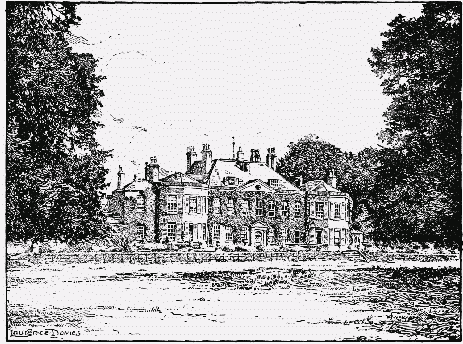
Scruton Hall: Principal Front
The village of Scruton lies 1½ miles from Bedale as the crow flies, though 4 miles by road and a mile from the Roman road from Catterick to Boroughbridge. It must have been along this route that the Scots came when Scruton was harried in about 1319. (fn. 2) Scruton Common stretches between the village and the Swale; it has not, however, been common within living memory. (fn. 2a)
At the present day the village consists of fifty-eight houses, lying for the most part on the east and north sides of a strip of grass planted with young limes; there are also two old elms. The population is mainly agricultural, though there are brick and tile works in the parish. In the 18th century Gale wrote that 'the present town contains about forty houses, besides seven more in the out-parts.' (fn. 3) In his day there was a 'pretty green' 'planted round with trees' before the church, which stands north of the village.
Roger Gale is buried in the churchyard, but with nothing to mark the place. By his own desire a stone with an inscription was placed above his coffin and completely covered with earth. (fn. 4)
A Wesleyan chapel built in 1879 stands on the east side of the road leading to the station.
Near the church and to the north of the green is Scruton Hall, the property and residence of the lord of the manor, the Rev. A. T. Coore, built by Roger Gale about 1705. The house is built of brick and consists of a two-storied central block with attics contained in a large hipped roof, crowned by a flat, and a wing on either side, added about 1820. In the park are two groups of ancient cedars of Lebanon planted about 1718; the trees, which in 1820 measured 9 ft. 9 in. to 10 ft. 6 in. in girth, are now somewhat decayed. The old manor-house, which stands on the south side of the village green, is a brick building of late 17th-century date with two diagonally set brick chimneys, a large two-light mullioned and transomed window on the first floor and a late two-light mullioned window on the ground floor.
In the hall are a few pieces of heraldic glass, among them a 16th-century shield of many quarterings, which seems to have no reference to the history of the house. Three shields of later date record matches of the Gales of Scruton.
A lane leads south from the village to Scruton station on the North Eastern railway. Grimescar Mill stands on a tributary of the Swale, which forms the southern boundary of the parish and is called at different points on its course Bedale, Leeming, and Grimescar Beck.
Manor
Before the Conquest two manors in SCRUTON were held by Cnut and Torfin, while Gernan had 2½ carucates. The whole was held in 1086 of Count Alan by his vassal Picot, (fn. 5) who was almost certainly the founder of the family of Lascelles (fn. 6) (de Sigillo). (fn. 7)
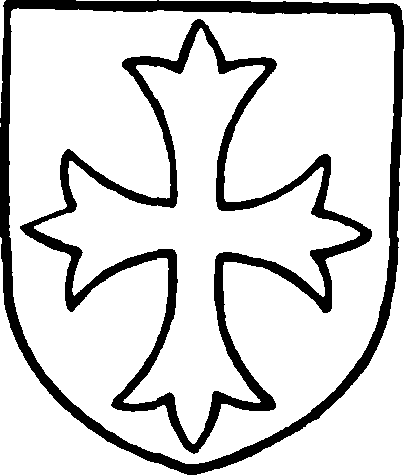
Lascelles. Sable a cross paty or.
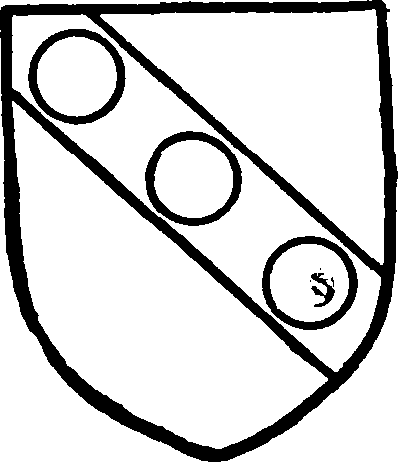
Markenfield. Argent a bend sable with three bezants thereon.
In 1209–10 Roger Lascelles was lord of Scruton. (fn. 8) He was succeeded by his son Picot, (fn. 9) who held two and a half knights' fees in Scruton, (fn. 10) and made an agreement with his nephew Roger under which, failing issue to himself, Roger should inherit all his lands. (fn. 11) Picot died without issue in the middle of the 13th century, and the manor was inherited by his niece Avis, as heir of her brother Roger (fn. 12); she received a grant of free warren here in 1253. (fn. 13) Avis married Adam de Pontois (Pontaies) (fn. 14) and was succeeded by her son Roger, called Roger Lascelles. (fn. 15) He was holding the manor in 1286, (fn. 16) and died at the end of the century, leaving as coheirs his four daughters, (fn. 17) of whom the eldest, Joan de Colewenne, inherited Scruton. (fn. 18) She granted it to Simon Ward, (fn. 18a) evidently for the purpose of a sale to John and Andrew Markenfield of Markenfield Hall in the West Riding, who received a grant of free warren to themselves and their heirs in that year. (fn. 19) The manor had been previously granted, presumably for a term of years, to Robert Catherton, (fn. 19a) whose son Alan claimed it in 1328. Judgement was given against him, (fn. 20) and Andrew Markenfield, on whom the manor had been settled in 1314, (fn. 21) was adjudged the rightful lord. This family (fn. 22) continued to hold the manor (fn. 23) until Thomas Markenfield was attainted and executed for his part in the Rebellion of the North. (fn. 24) Scruton was granted by the Crown in 1571 to George Bowes and others, (fn. 25) who sold the manor a few years afterwards to Thomas Danby of Thorpe Perrow (fn. 26) (q.v.). Thomas was succeeded by Christopher Danby, on whom the manor was settled in 1611. (fn. 27) He died seised in 1624, leaving a son and heir Thomas. (fn. 28) Scruton was among the sequestered lands of Sir Thomas Danby in 1646. (fn. 29) In 1688 it was sold by Sir Abstrupus, Christopher and Anne Danby to Thomas Gale, D.D., afterwards Dean of York. (fn. 30) The Gales were already possessors of land in Scruton (fn. 31) and resided here. They were a well-known antiquarian family, Roger the son of Thomas being the editor of the Registrum Honoris de Richmond. (fn. 32) He died in 1744, (fn. 33) and was succeeded by his son Roger Henry. The manor was carried into the Coore family by the marriage in 1816 of Harriet Gale, daughter and heiress of Henry Gale and granddaughter of Roger Henry, with Lieut.-Col. Foster Lechmere Coore. (fn. 34) The Rev. A. T. Coore, their grandson, is the present owner.
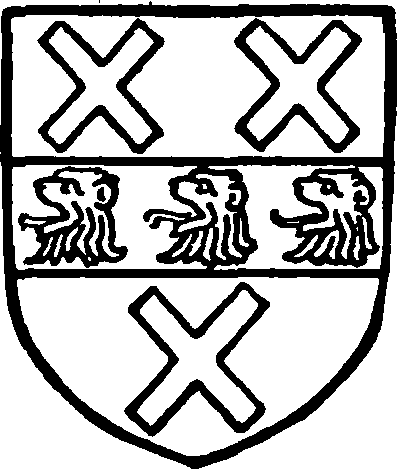
Gale. Azure a fesse between three saltires argent with three lions' heads razed argent on the fesse.
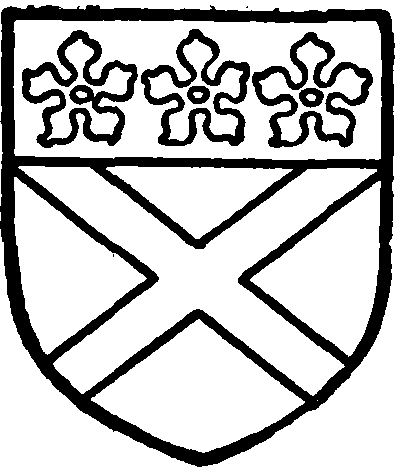
Coori. Argent a saltire and a chief sable with three cinqfoils or in the chief.
By the settlement of 1314 on Andrew Markenfield the reversion was secured to Henry Lord Scrope, (fn. 35) who probably had some land here already. It does not appear that the heirs of Andrew in the direct line ever failed, but the Scropes nevertheless in the 15th century (fn. 36) claimed a right in the manor possibly based on this settlement. When Geoffrey Lord Scrope died in 1517 one of his heirs was Alice wife of Sir James Strangways, (fn. 37) and the Strangways family succeeded to the claim on Scruton. (fn. 38) It was conveyed by them to the Dacre family by a fine of 1541, (fn. 39) and confirmed to them by the Parliamentary award of the Strangways' lands. (fn. 40) On the attainder of Leonard Dacre in 1570 whatever right he had in the manor passed to the Crown. (fn. 41) At the end of the 17th century, however, the Earl of Carlisle unsuccessfully claimed the manor by reason of his descent from Sir James Strangways. (fn. 42)
A yeoman family bearing the name of Scruton were freeholders here from the 13th to the 17th century. (fn. 43)
Land in Scruton, probably granted by a member of the Lascelles family, was confirmed to Jervaulx Abbey in 1268 by John Duke of Britanny. (fn. 44) In 1253 Maud widow of Picot Lascelles successfully claimed dower against the abbot in Scruton. (fn. 45)
Two oxgangs and a toft in Scruton, of the gift of Picot Lascelles, were in the possession of the Knights Templars in 1185. (fn. 46)
A free fishery was appurtenant to the manor in the 17th and 18th centuries. (fn. 47)
The manorial mill is mentioned in 1209, 1628, and 1688. (fn. 48)
Church
The church of ST. RADEGUND consists of a chancel 28 ft. 9 in. by 16 ft. 2 in., north vestry, north chapel or organ chamber 12 ft. 6 in. square, nave 56 ft. by 19 ft., north aisle 12 ft. wide in its eastern half and 7 ft. 10 in. in its western, south aisle 7 ft. 10 in. wide, south porch and west tower 8 ft. 6 in. square. These measurements are all internal.
At the drastic 'restoration' in 1865, which was practically a rebuilding, the history of the church was almost entirely effaced (fn. 49); so far as can now be discovered, the building was of 12th-century date with 13th-century aisles and chancel and 15th-century tower. The only old windows left in the building are the three south windows of the chancel, two of the 13th century and one of the 14th, and another in the north aisle probably not in its original position. The south doorway is late 12th-century work, and was evidently moved out when the 13th-century aisles were added. Owing to the recutting of the stonework of the arcades the mould forms differ entirely from the original sections. The vestry, chapel and porch are new additions.
The first two windows in the south wall of the chancel are lancets of 13th-century date, while the third is apparently a 14th-century insertion of two ogee-headed lights, robbed of their cusping, under a square head. Below the eastern lancet is a roundheaded recess used as a credence. The axial line of the chancel deflects to the south from that of the nave. The nave arcades are each of four bays with circular columns having moulded bases and capitals and half-round arches of two chamfered orders; the inner orders at the east end are carried on corbels and at the west on small engaged shafts. Below the east corbel of the north arcade the recut trefoiled head of a piscina recess has been reset, the bowl of which has disappeared.
The eastern half of the north aisle constituted the Scruton chantry, (fn. 50) and was shut off by a wooden screen which existed as late as 1780. (fn. 51) It is lighted by two windows, the first of which is an opening of early appearance with a peculiar little foil cut out of what otherwise would have been a round head; the second window is modern and of two lights. Opposite to the middle pier the aisle narrows by 4 ft. 3 in., and immediately to the west of the return is a tiny porch with an outer doorway. The south doorway, somewhat re-dressed, is evidently of 12th-century date; the jambs are of two orders, the inner one with an edge roll which continues in the round arch, the outer slightly chamfered, the arch being moulded with a roll between two hollows. The old thickness of the wall is retained at the doorway, the eastern jamb being 3 ft. 7 in. and the western 4 ft. 3 in., while the rebuilt wall on either side of the porch is not more than 2 ft. 7 in. The west and south-west windows of the aisle are round-headed, and both of modern stonework. An old shallow buttress against the face of the west wall is probably an untouched relic of the 12th-century work.
The tower is built of ashlar in three stages. The pointed arch opening towards the nave is of two chamfered orders springing from chamfered and hollowed abaci; on the faces of the last are carved two small grotesque figures. The stair turret, which rises at the north-east corner, is entered from the nave by an elliptical-headed doorway. The west window is modern. Over it is a small clock face. The middle stage is lighted by a small rectangular light to the south. The walls of the bell-chamber are pierced on each side by two plain ogee-headed lights (probably once cusped). The western angles of the tower are strengthened by diagonal buttresses of six stages reaching to the offset below the belfry stage. The upper parts of similar buttresses appear outside on the east face. The embattled parapet has no coping stone; at the angles are grotesque gargoyles. All the roofs are modern and of plain design.
The font and the rest of the furniture are of recent date.
The only old gravestone to be found is one in the churchyard east of the vestry with moulded edges and a floreated cross partly worn away.
There are three bells, two by Mears, 1814; the third is inscribed with a Lombardic letter H, and has, besides, a shield charged with a cheveron between three laver pots, a floreated cross, and another shield with a cheveron between three slipped trefoils; these are the marks of William Dawe, a London founder of the end of the 14th century.
The plate includes a cup of 1571 restored in 1709 by Roger Gale and again in 1902, a cover paten of the same date as the cup, a paten of 1676 presented by Roger Gale in 1737 and a pewter flagon.
The registers begin in 1572.
Advowson
The advowson was the possession of the lord of the manor, Roger Lascelles, (fn. 52) at the close of the 13th century. It was held by John and Andrew Markenfield, but while the manor was settled on Andrew and his heirs, (fn. 53) the advowson was inherited by William de Munketon, 'kinsman and heir of John,' (fn. 53a) who granted it in 1335 to Sir Geoffrey le Scrope. (fn. 54) It followed the descent of the manor of Masham (fn. 55) (q.v.) until the division of 1517, when it seems to have been part of the share of the Danbys, who continued to present. (fn. 56) Towards the end of the 17th century the Earl of Carlisle claimed it as the descendant of Sir James Strangways, and actually presented in 1665 and 1670, (fn. 57) but in a suit which followed his claim was pronounced invalid, and the advowson was sold in 1688 by the Danbys to Thomas Gale. (fn. 58) It has followed the descent of the manor, though during part of the 17th and 18th centuries it was in the hands of the Turner family, (fn. 59) probably lessees.
William Scruton had licence in 1335 to grant lands in Scruton to a chaplain to celebrate daily in the parish church for the souls of William and his wife Maud and their ancestors. (fn. 60) John Bretteville had licence in 1387 to effect an exchange with the chaplain of this chantry. (fn. 61) In the survey of 1546 it was found that the 'stypendarye pryste' 'hath byn paid a yerely rent of 20s. by Thomas Rokeby of Mortein and his auncestors, forth of the landes some tyme Yaforth landes, and the same pryste sayth wekely ones in the weke masse at the parysshe church of Scruton.' (fn. 62) This does not appear to be the chantry of the Scruton family, but there is no record of a later foundation.
Charities
The following charities mentioned in the table of benefactions are still in operation, namely: Poor Folks Close, consisting of 1 a. 1 r., supposed to have been devised by will of William Whitwell, date unknown, let at £3 a year; Jackson's rent-charge of 30s. charged by deed 1684 upon a parcel of land called Place's Field; Roger Gale's rent-charge of 40s. for coals; Isles's rent-charge of £4 for the poor on New Year's Day; John Fisher's rent-charge of 10s. for the poor at Christmas; John Brewster's rent-charge of 10s. for the poor on 13 February; Mr. Heddon's rent-charge of 10s. for the poor at Easter; and Mr. Langdale's rent-charge of 10s. for the poor on 15 February.
The six last-mentioned payments, amounting to £8 a year, are paid out of the Coore estates by the Rev. Alfred Thomas Coore of Scruton Hall, and are applied with the income of the two first-mentioned charities in the distribution of money, beef, coals and milk, and in medical relief when required.
